The most common avocado varieties grown in Colombia are Antillana (Persea americana Mill.), Guatemalteca (P. americana var. guatemalensis), and Mexicana (P. americana var. drymifolia), and hybrids between them (Vega 2012; Crane et al. 2013). Avocado crops in the lowlands have a precarious implementation of agronomics practices; however, the domestic markets prefer the product due to its bigger size and distribute it in bulk. Conversely, the cultivated area in the Colombian Andean Mountains have been expanding in the last two decades (15,530 ha) (MADR 2018), It has been stimulated mainly by exports mostly of the Hass variety due to both its pulp quality and high productivity (Arias et al. 2021). The expanding fields come from the conversion of pastures, meadows, and fallow lands, in areas with high slope (>75%) (MADR 2018). In the arable fields of the temperate regions, several authors agree that the most determinant factors in the weed species composition are the type and preceding crop, crop rotation, sowing season, and tillage intensity. Environmental factors such as altitude and soil properties, although significant, remain less relevant (Nowak et al. 2015; Wells et al. 2014; Hanzlik and Gerowit 2011; Pinke et al. 2010; Šilk et al. 2009). However, Pinke et al. (2012) studying the influence of the environment, management, and site context on species composition of summer arable weed vegetation found that even for intensified agriculture, the effects of environmental factors were more important than management strategies. In Colombia, the hill landscape where the Hass avocado variety is increasing prevents tillage during both crop establishment and maintenance (Vega 2012); moreover, the perennial characteristic of the crop does not allow crop rotations and reduce the strategies available within an integrated weed management program.
The management of perennial weeds is the principal concern for the crop. An increase has been observed because their root system is not disturbed by management practices, it is favored by low inter-specific competition, and most herbicides are not fully efficient (Bajwa 2014). Buhler et al. (1994) suggest that management of established perennial weeds in reduced tillage fields is ineffective and may increase the spread of roots with vegetative reproduction. Hatcher (2017) reported changes in weed floras associated with reduced-tillage systems and cited, the increase of monocot and dicot species in the absence of tillage. Thereby, perennial weed dominance excludes floristically abundant annual species (Boatman et al. 2011); however, Buhler (1995) advises exercising caution before making statements of an increase of perennial weeds because the situation can vary among sites as a result of interactions of tillage with weed management practices, the environment, and initial perennial weed populations. Management practices such as selective application of systemic herbicides to tall-growing perennial weeds, row-space, and inter-row cultivation help reduce the density of perennial-species, regardless of the tillage system, to levels that do not reduce crop yields nor increase management costs (Streit et al. 2002). Exploration of weeds distribution and their interactions with other variables can help us adjust management strategies and establish ecological balances between weeds and crops (Olorunmaiye et al. 2011; Bastiaans et al. 2000).
The objective of the study was to evaluate the influence of weed management and edaphic properties on the composition of the weed communities, in no-till avocado orchards in the highlands of eastern of Antioquia, Colombia.
MATERIALS AND METHODS
Agroecological characteristics
Avocado orchards mainly Hass variety are expanding in the eastern Antioquia, in Colombia highlands (Figure 1). Table 1 shows the most representative soil type reliefs and Holdridge life zones and details the nine municipalities of the study. The eastern region has a broad diversity of environments and landscapes, with high and low hills, terraces, and alluvial plains. Its soil is formed from the weathering of igneous rocks and covered by a thin layer of volcanic ash, which give it andic properties. These soils are acid and have poor content of nutrients, high phosphorus fixation, and variable cation exchange capacity (Jaramillo 2009; IGAC 2007). According to Holdridge's life zone classification system, there are two land areas: the lower montane moist forest and the lower montane wet forest (Holdridge 2000). The study region presents an altitudinal range between 1,800 and 2,500 masl, an average annual temperature of 17 °C and rainfall of 2,000 mm (IGAC 2007).
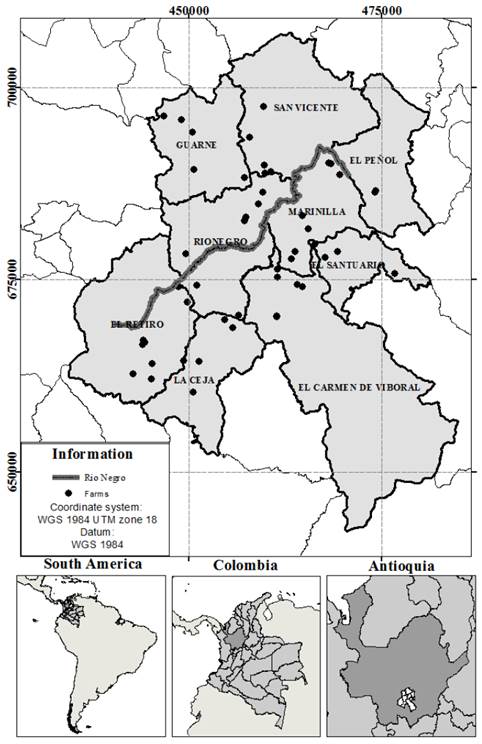
Figure 1 Map of the spatial distribution of the fifty avocado orchards, situated in the highlands of the eastern, Antioquia, Colombia.
Table 1 Description of the most representative soil taxonomic units of the study region including the Holdridge life zones (IGAC 2007).
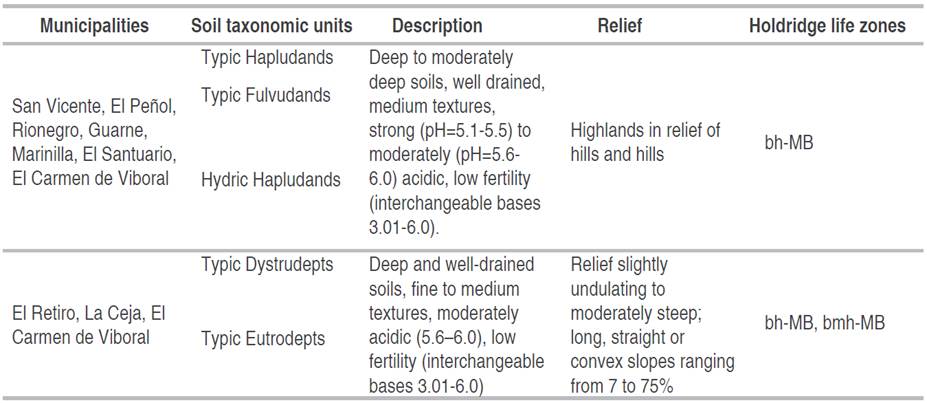
Sampling
The fieldwork took place between 2016 and 2017 in 50 Hass avocado orchards distributed in nine municipalities (Table 1). The perimeter of the avocado orchards was established with a 62sc Garmin map GPS receiver, configured under the WGS84 UTM projection system zone 18N. The coordinates of 20 sampling points elaborated with mesh distribution on the digital map of each orchard plot were exported to the GPS (Figure 1). Each sampling site was identified in the field of the orchards surveyed using the GPS.
Evaluation and identification of weeds
The weeds were sampled among the crop grooves, avoiding the dripping of the trees and considering tree shading, the applied organic matter, and the manual handling that limits the representation of the established weeds in the system. A square frame (0.5x0.5) m was set to define each sampling point. The frequency (F%) (Equation 1) and dominance (d%) (Equation 2) were calculated based on the presence and visual cover (%) of each species identified in the frames.
Where, for i-n species, Fspi: average frequency (%), xspi: frames with the specie n: total sites in the orchards, dspi: average dominance (%), and cspi: visual cover of specie in the frame.
Their relative composition was estimated using the expressions in the Equations (3, 4).
The Importance Value (IV) (Equation 5), which reveals the significance of the species in the weed composition, was estimated as the sum of the relative frequency and the relative dominance.
The IV is a modified indicator of the phytosociological importance of weed types in a community; it compares them individually and jointly by the frequency and dominance (Bhadra and Pattanayak 2016). We classified the weed biotypes in the Medel herbarium of Universidad Nacional de Colombia.
Weed management and edaphic variables
A semi-structured survey was used to collect the information related to weed management. The categories defined to group the strategies were chemical and mechanical management. In the last group, the order of rotation of the tools was considered, such as brush cutters, machete, or manual eradication (Table 2). In the case of chemical management, it is important to ask about the types of herbicides used. In the soil, the evaluated variables were the maximum moisture retention capacity (MMRC) and pH. The MMRCs were determined using perforated cylindrical brass boxes of volume 22 cm3 and known weight. The soil samples dried at 105 °C were passed through a 1 mm sieve, packed in the cylinders, and weighed. The packed samples were saturated with water and the excess was drained. Finally, the cylinder with the moist soil was weighed and the MMRC (%) was estimated. The pH was determined by the potentiometric method in the laboratory on a 20 mL sample of dry soil suspended in 50 mL of water (soil - water ratio 1:2.5 V V-1) (Weil and Brady 2016). In both cases, each sampled site was evaluated by triplicated.
Statistical analysis
The statistical analysis of the data was made in three steps. 1) Selection of the ten species with the highest IV obtained as the average of all the IVs in the 50 farms and their average distribution in the territories, according to the farms monitored in each municipality. The differences between species in the IV was established by the Kruskal-Walli's test, given the non-normality of this variable. 2) Evaluation of the relationship between weeds dominance as response variable and factors: region (nine municipalities), management forms (five mechanical and two chemical), and soil (MMRC and pH) as explicative variables, and a non-linear Poisson link function through a generalized linear model. 3) Graphical description of the implemented weed management strategies. The Statistical analysis was performed using the R Project programming language (The R Core Team 2021).
RESULTS AND DISCUSSION
Weed composition
In total, 94 weed species were identified, 66 dicots and 28 monocots, within 33 botanical families. The families Asteraceae and Poaceae stand out with the highest number of species. Figure 2 shows the 10 species of weeds with the highest IV. Two perennial and one annual species of the Poaceae family occupy the first three positions of the IV ranking.Melinis minutifloraP. Beauv,Digitaria horizontalisWild, and Pennisetum clandestinumHochst ex Chiov presented the largest population in the studied territory with average dominance values higher than 0.1 (10%), thus being dominant in six, five, and three municipalities out of the nine involved respectively (Table 3). The occurrence and dominance of the species Bidens pilosaL., Hypochaeris radiata L, Persicaria nepalense (Meisn.) Miyabe, and Taraxacum campylodes G.E. Haglund were low (Dominance<0.009) throughout the region. For the other species Pteridium aquilinum L. Kuhn, Oxalis corniculata L., Commelina diffusa Burm.f. the dominance was above 0.1 in at least one municipality and maximum in three (Table 3); this behavior is in the middle of the two previous groups.
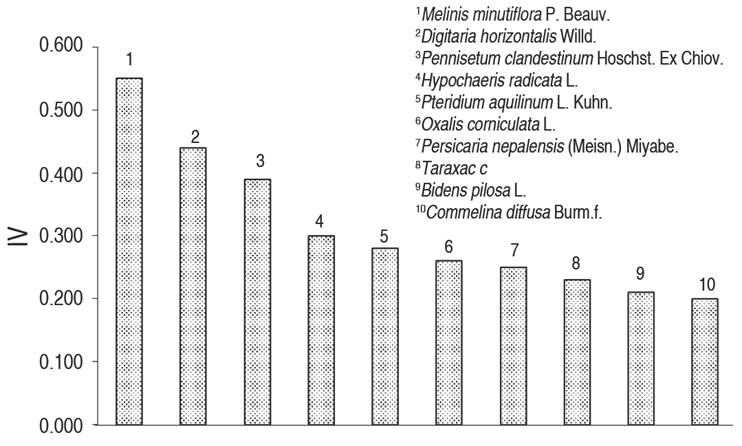
Figure 2 Importance value index of weeds in the avocado orchards in the highlands of eastern Antioquia, Colombia. Equal letters on the bars indicate no significant differences between the Importance Value of the species, based on the Kruskal-Walli's test (P<0.05).
Table 3 Average dominance of the 10 largest IV species in Hass avocado crops in the highlands of eastern Antioquia, Colombia.
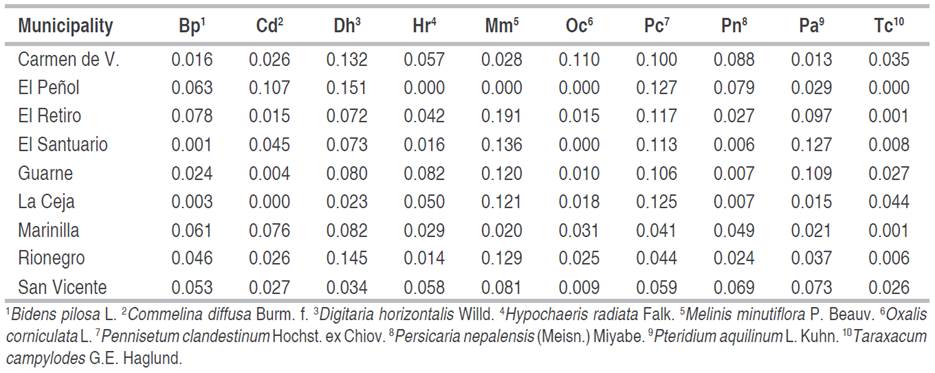
Within the three most significant species,M. minutiflora and P. clandestinum are perennial, rhizomatous weeds with matted roots and grass-like, herbaceous habits. They are native to the highland regions of east Africa. D. horizontalis is an annual weed distributed in the high and humid lands of the savannah and forests of Africa. Although those three species are considered forage, in the tropic, they grow fast and have become dominant species in the cultivated fields, replacing the native flora (Romero et al. 2004). Furthermore, D. horizontalis is reported with the highest aggressiveness, mainly in annual crops (Giraldo-Cañas and Baptiste 2017; Johnson and Kent 2002). In the upland rice, densities of 10 plants m-2 of this species reduce 40% of the production. There are few studies on the impact of this species in the perennial crops; however, Olorunmaiye et al. (2011) and Lemes et al. (2010) report intermediate to low interference in citrus and coffee, respectively.
Territory, soil, and agronomic management factors
Table 4 shows the dominance relationships of the 10 species with higher IV as a function of the factors, region, management strategies, and soil. The municipality was the most relevant characteristic related to species presence or absence in the distribution. In this sense, the orchards located in El Carmen de Viboral, had unfavorable conditions for the presence of weeds. Meanwhile, the other towns presented favorable conditions for some weeds and adverse for others. In the municipalities with less favorability producers have a better rotation of the chemical and mechanical management strategies. Figure 3 shows the management strategies implemented in different farms and compares them by municipalities. 35% of the evaluated farms managed weeds by rotating brush cutters-manual-machete (B-Mn-Mch). Rionegro was the most representative with 8%, followed by Marinilla and El Retiro, representing 6% each. The brush-cutters-manual (B-Mn) rotation practice in weed management represent 28% of participation and is the second most used procedure. The use of brush cutters (B) is in third place with 20%. The least used practices (10% and 8%) were the combination of brush-cutters-machete (B-Mch) and only the of machete (Mch), respectively.
Table 4 Association of factors municipality, weeds management, and soil pH and MMRC, with the dominance of the ten species of weeds with higher IV in Hass avocado orchards using a generalized lineal model with a non-linear Poisson link function.
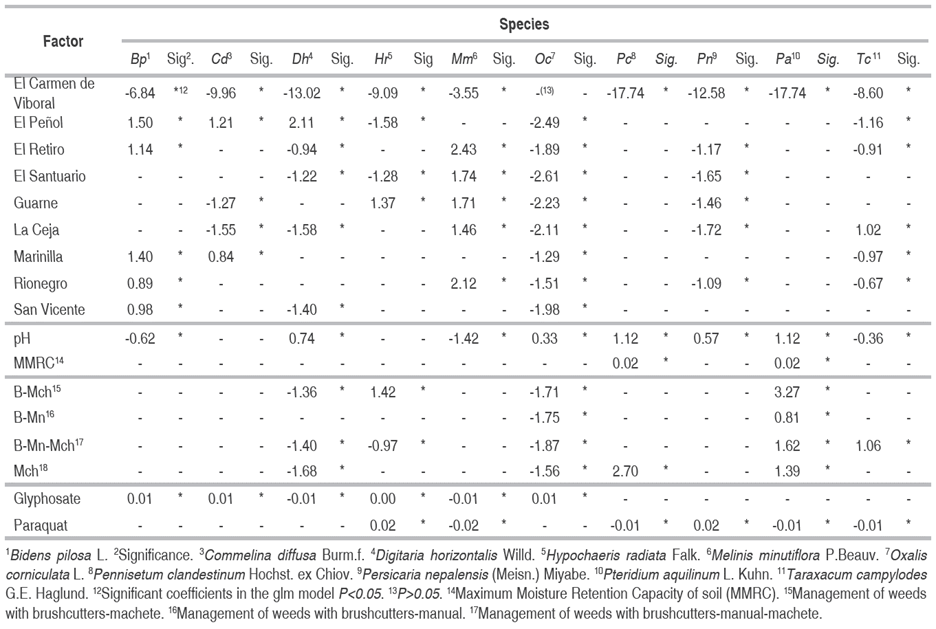
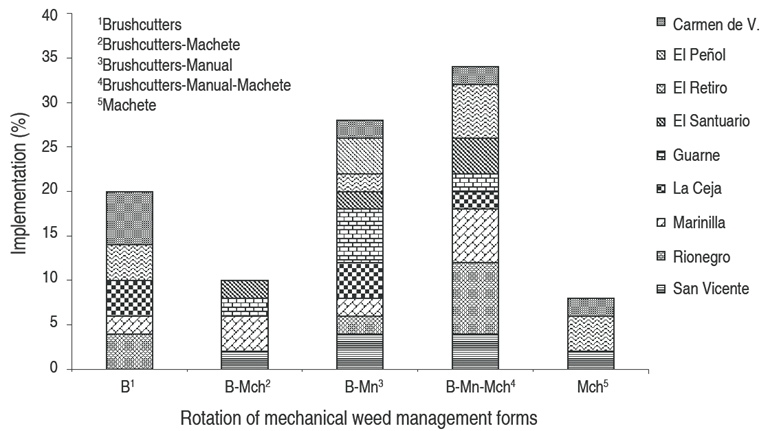
Figure 3 Rotation of mechanical handling of weeds in Hass avocado orchards in the highlands of eastern Antioquia, Colombia.
On the other hand, chemical management is another of the strategies of great use in the territory; 80% of the 50 farms evaluated use glyphosate as one of their main management strategies, while paraquat occurred in 44% (Figure 4).
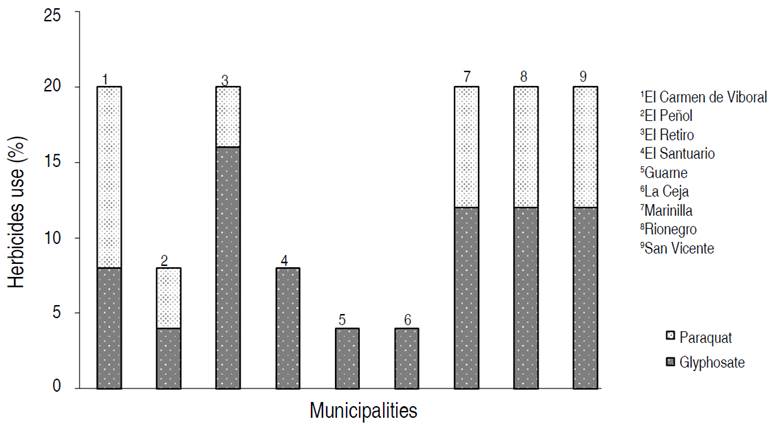
Figure 4 Type of herbicides used in Hass avocado orchards according to the municipality of the eastern region, Antioquia Colombia.
The differences in the weed composition to the municipality scale show the modulation groups by local practices according to the landscape effect. This view implies differential spatial dynamics for management, which may represent a lever to hinder, or favor weed spread and persistence in agroecosystems (Petit et al. 2013; Gabriel et al. 2009).
The dominance of M. minutiflora is favored significantly in five of the nine municipalities. Although the mechanical management did not show significant incidence, is favorable for the propagation and tillering of this highly invasive species. Chemical management affects the dominance of this weed, and it is recommendable as a management strategy directed to its patches and thus favors the establishment of soft species. The municipality factor influenced the distribution of D. horizontalis significantly; being direct in one and inverse in five of them. Additionally, mechanical and chemical management factors impact the establishment of this species. Although most strategies work well, the brush cutter-manual-machete rotation is the most used method in the study region. The pH also had an indirect effect on D. horizontalis, thus indicating a positive relation with the acidic conditions of the soils.
The positive relationship of P. clandestinum with pH and MMRC factors evidenced a higher dominance of this species in wet soils with moderate acidity. This narrow-leaf (monocots) species presented positive relation with machete management (Mch) favors its competence and dispersion capacity (reproduction by stolon). The use of paraquat diminishes the dominance of this species and promote the germination and growth of others. Regarding H. radicata, the municipality factor had a positive effect in one and negative in three of the nine sampled municipalities. The chemical factor favors its establishment mainly because it eliminates the competition with the narrow-leaf weeds and enables the germination of seeds from the seed bank (Schoenfelder et al. 2010). Mechanical management strategies also have a significant impact; the brush cutters-machete rotation is positive, and the brush cutters-manual-machete rotation is negative, for the dominance of this species. Kroon et al. (1987) evaluated the population dynamics of perennial grass and H. radicata under different mechanical management frequencies by density-dependent simulation models. The show that the cut favors the vegetative branch and consequently the increase in the size of the rosette. Manual weeding affects the H. radicata dominance since the plant cannot increase the rosette. This species can be said to be sporadic in the process of succession rather than a competing weed.
The species B. pilosa registered a low IV in all municipalities; nevertheless, the factor was favorable for its distribution in five of the nine evaluated municipalities. The chemical management of weeds was frequent in all territories, and the main active ingredient was glyphosate. The bare ground patches allow the germination of dormant seeds in the seed bank; consequently, less competitive species such as B. pilosa have the opportunity to grow and increase their importance. The pH of the soil also has significant adverse effect (P<0.05) in the dominance of the weeds.
Based on the results, the distribution of the Commelina diffusa Burm.f. species is regulated by the territory factor. Therefore, three municipalities reduced and two favored its dominance. The first ones made greater use of herbicides in orchards and later did the opposite. This result suggests that despite its low competitive capacity, it grows fast, and its establishment can be enhanced as a useful plant in the avocado orchards under reasonable herbicide use.
In the avocado orchards, Oxalis corniculate L, Persicaria nepalensis (Meins) Miyabe and Taraxacum campylodes G.E. Haglund are rare and non-aggressive species. Most of the factors have a negative impact. The positive effect of the chemical management on them is due to a decrease in the frequency and dominance of the most competitive weeds, i.e., mostly narrow-leaf species, principally. Furthermore, pH presented a direct relationship with O. corniculata and P. nepalensis species and inverse with T. campylodes.
CONCLUSIONS
Three foreign species dominate the weeds communities (IV>0.39) in the highlands with expanding avocado orchards in Antioquia, Colombia (M. minutiflora, D. horizontalis, and P. clandestinum). The high slopes restrict tillage and favor the distribution and dominance of these species in the territory. The municipalities are grouping the effects of similar management strategies and cultural practices in the region. The chemical management favored the equilibrium of the weed composition, while mechanical management did not, due to greater pressure on the most competitive species, thus favoring their establishment. Finally, the humidity and pH, although with significant effect, have less influence on weeds' distribution and dominance.





















